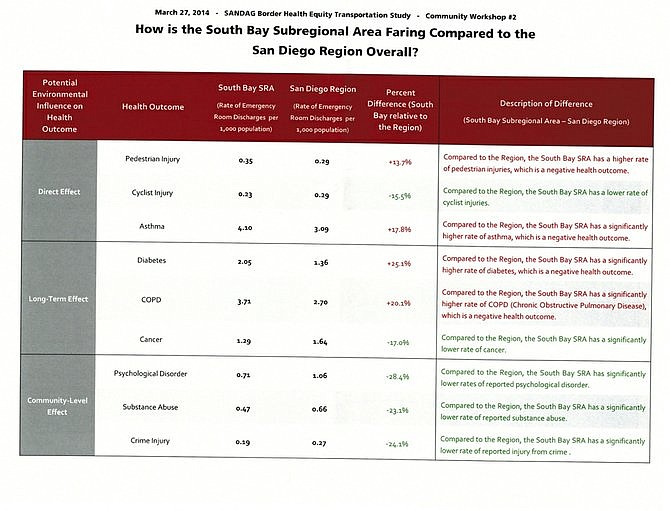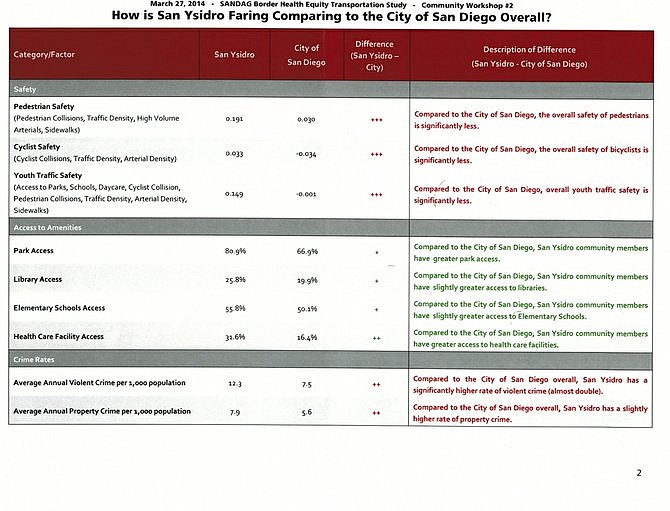 Facebook
Facebook
 X
X
 Instagram
Instagram
 TikTok
TikTok
 Youtube
Youtube

On October 23, SANDAG presented its “Border Health Equity Transportation Study” at the San Ysidro Civic Center.

The study found that the South Bay has a 17.8% higher rate of asthma, a 25.1% higher rate of diabetes, and a 20.1% higher rate of COPD (chronic obstructive pulmonary disease) than the San Diego region as a whole.
The study did show some good news. The South Bay sub-regional area has a 17% lower rate of cancer, 28.4% lower rate of reported psychological disorders, and 23.1% lower rate of reported substance abuse. The San Ysidro community specifically had greater access to parks, libraries, elementary schools, and health care facilities as compared to the City of San Diego.

However, the study also found that pedestrian, bicycle, and youth traffic safety is significantly less in San Ysidro than the City of San Diego. A higher rate of violent crime (almost double) and a slightly higher rate of property crime exists in San Ysidro. Finally, the percent of households within 500 feet of transportation-related air-pollution sources in San Ysidro is 41.3%, compared to only 12% for the City of San Diego.
SANDAG senior regional planner Dan Gallagher said, “We received community input at workshop number two, which happened last March when we asked the community to prioritize the recommendations and see if there are any gaps or if we missed anything. Then, finally, we came up with a list of 13 prioritized recommendations. Three additional recommendations were given by stakeholders.”

Dr. Sherry Ryan, SANDAG’s consultant from Chen Ryan Associates, described the 16 recommendations in a PowerPoint presentation. She said, “There was a wonderful recommendation to build what they were calling a ‘green spine’ along the light-rail corridor basically to give community members some green space, some opportunity for traveling in an environment separated from vehicles. That was ranked number one by the community.”
The recommended list of improvements included a bike lane along Otay Mesa Road, a ten-acre park on the east side of Beyer Elementary School, and a reconfiguration or relocation of the Camiones Way Transit Station.
Ryan added, “What we found missing from all the currently adopted planning documents was a real serious lack of recommendations that might inform or help address serious air-quality issues that are in San Ysidro.”
She then explained that the region needed to establish an air-quality monitoring program.
“We know there is a stronger incidence of asthma in San Ysidro than in other parts of the county. We want to understand if, in five years, has San Ysidro gotten better or worse. So, we need to be tracking that information and we also need to be tracking how health varies over time in relation to pedestrian improvements and improvements in access to transit.”
SANDAG’s 16th recommendation was to find funding sources for the infrastructure improvements.


On October 23, SANDAG presented its “Border Health Equity Transportation Study” at the San Ysidro Civic Center.

The study found that the South Bay has a 17.8% higher rate of asthma, a 25.1% higher rate of diabetes, and a 20.1% higher rate of COPD (chronic obstructive pulmonary disease) than the San Diego region as a whole.
The study did show some good news. The South Bay sub-regional area has a 17% lower rate of cancer, 28.4% lower rate of reported psychological disorders, and 23.1% lower rate of reported substance abuse. The San Ysidro community specifically had greater access to parks, libraries, elementary schools, and health care facilities as compared to the City of San Diego.

However, the study also found that pedestrian, bicycle, and youth traffic safety is significantly less in San Ysidro than the City of San Diego. A higher rate of violent crime (almost double) and a slightly higher rate of property crime exists in San Ysidro. Finally, the percent of households within 500 feet of transportation-related air-pollution sources in San Ysidro is 41.3%, compared to only 12% for the City of San Diego.
SANDAG senior regional planner Dan Gallagher said, “We received community input at workshop number two, which happened last March when we asked the community to prioritize the recommendations and see if there are any gaps or if we missed anything. Then, finally, we came up with a list of 13 prioritized recommendations. Three additional recommendations were given by stakeholders.”

Dr. Sherry Ryan, SANDAG’s consultant from Chen Ryan Associates, described the 16 recommendations in a PowerPoint presentation. She said, “There was a wonderful recommendation to build what they were calling a ‘green spine’ along the light-rail corridor basically to give community members some green space, some opportunity for traveling in an environment separated from vehicles. That was ranked number one by the community.”
The recommended list of improvements included a bike lane along Otay Mesa Road, a ten-acre park on the east side of Beyer Elementary School, and a reconfiguration or relocation of the Camiones Way Transit Station.
Ryan added, “What we found missing from all the currently adopted planning documents was a real serious lack of recommendations that might inform or help address serious air-quality issues that are in San Ysidro.”
She then explained that the region needed to establish an air-quality monitoring program.
“We know there is a stronger incidence of asthma in San Ysidro than in other parts of the county. We want to understand if, in five years, has San Ysidro gotten better or worse. So, we need to be tracking that information and we also need to be tracking how health varies over time in relation to pedestrian improvements and improvements in access to transit.”
SANDAG’s 16th recommendation was to find funding sources for the infrastructure improvements.
Comments